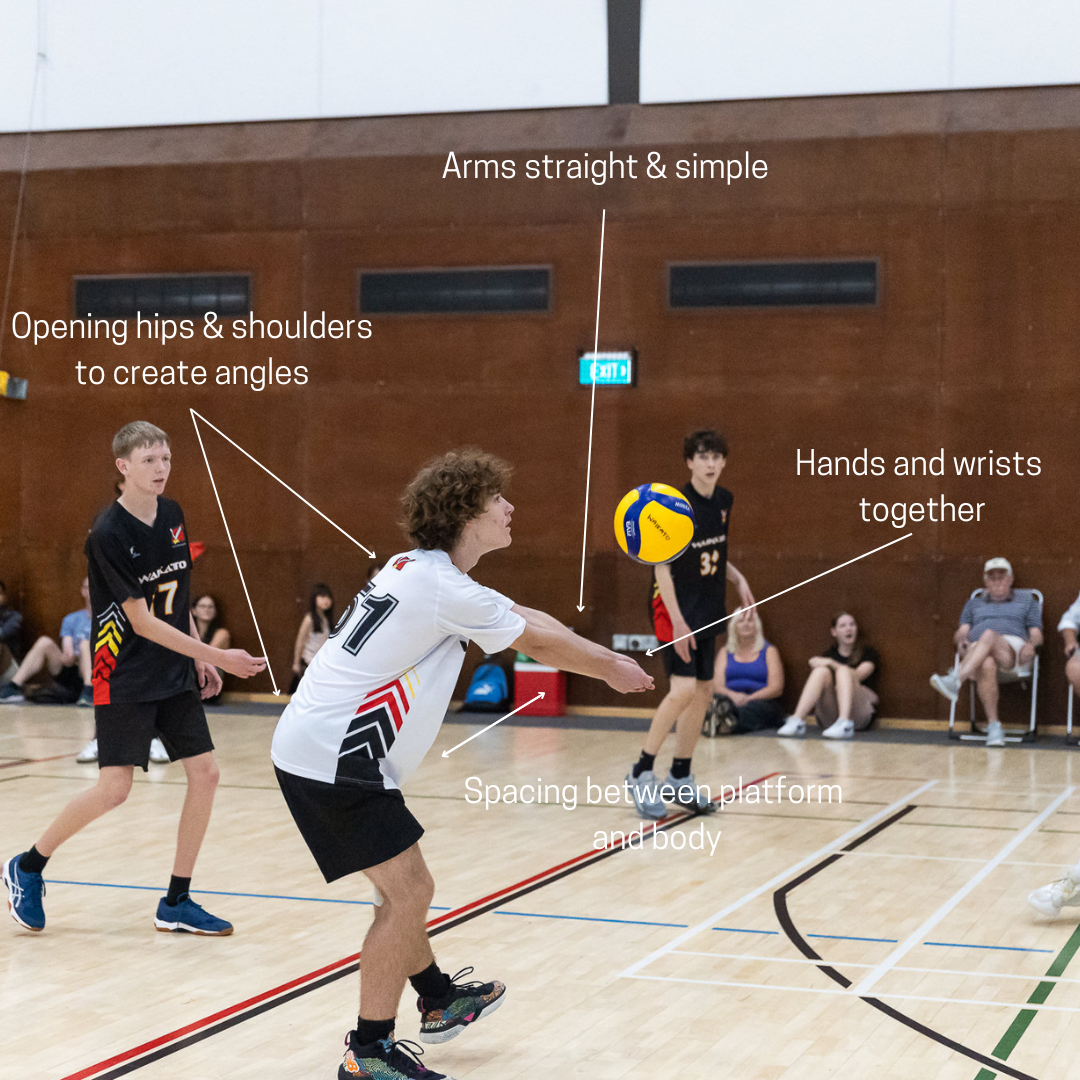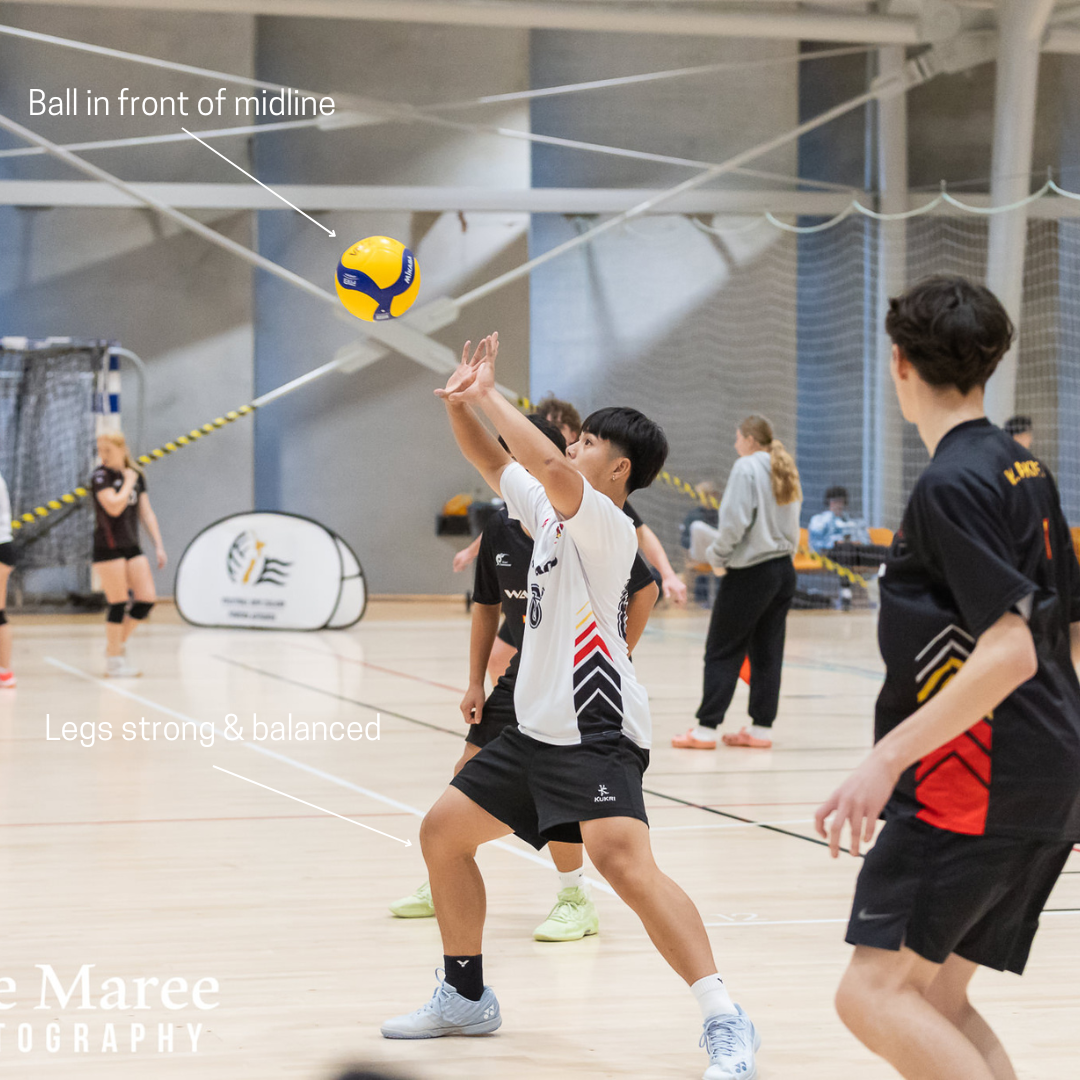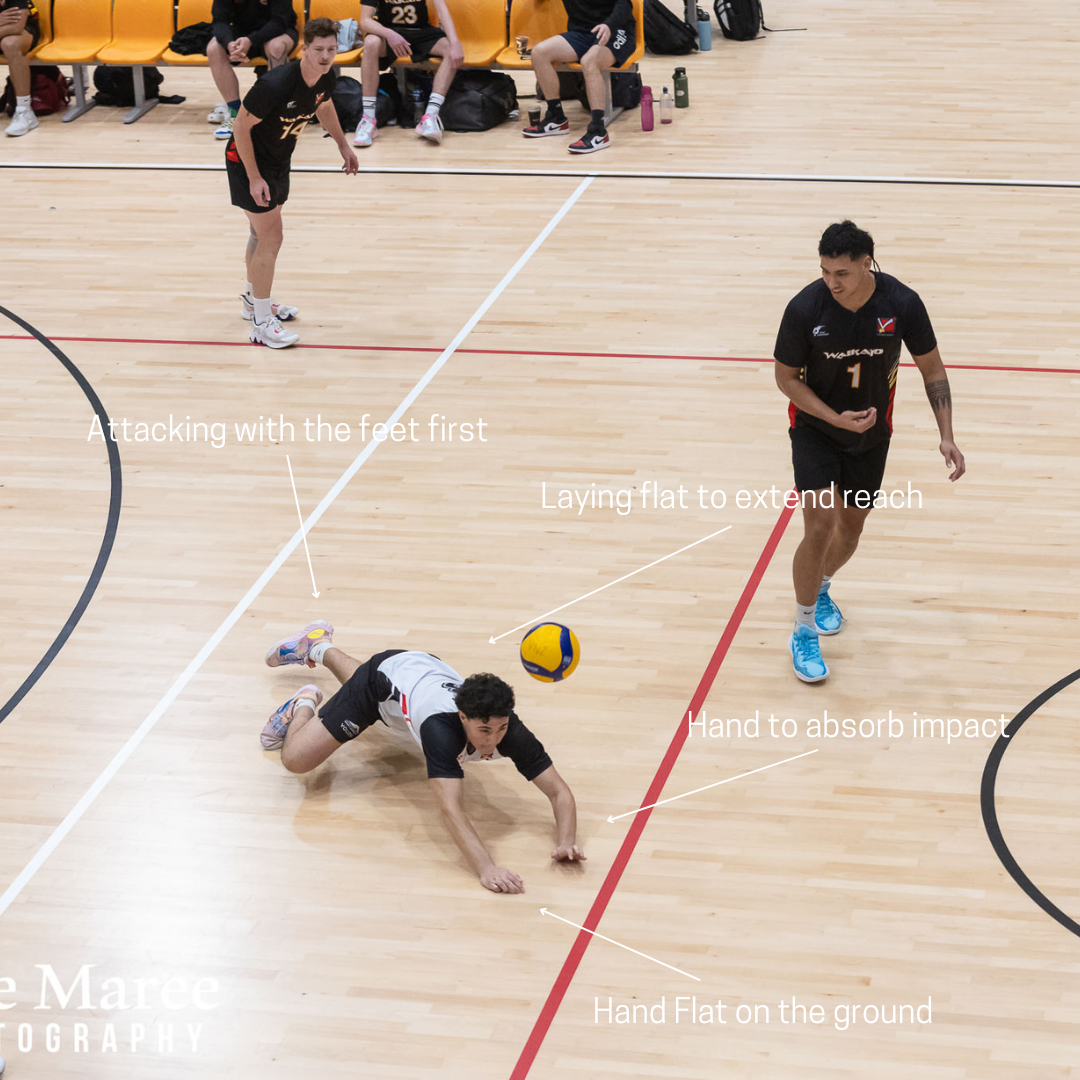
PASSING is a skill of continuity and is primarily used to control the opponent’s serving and attacking. Passing is the first step in the team's offensive sequence. Without an effective pass, the setter will be limited in their setting option which lowers the team’s chances of scoring a point.
Forearm Pass
Passing refers to the basic skill of using our forearms to create a platform to pass the ball to a target. It is important that we understand the techniques and action before going into a serve receive or digging situation.
-
We always want to start in an athletic (loaded/ready) position. This will allow us the best chance to move to the ball.
Start with your feet slightly wider than shoulders, bend at the knee, weight forward but back straight and looking up at the action. This ready position helps us be stable and ready to move quickly.
Have your hands out in front facing the source of the ball and ready to move.
When the ball is hit, move your feet to the ball by using shuffle steps or other efficient steps.
See the server or the attacker (play with your eyes first). You should be able to see where the ball is going to after they contact the ball.
-
Move your feet first, then stop before you pass the ball. Try to beat the ball, not just meeting it.
Your hands and wrists (your platform) comes together before you pass the ball.
Your hands and wrists should be together straight and simple.
Your platform is balanced and low.
Spacing between arms and body is important.
Swing your platform to pass the ball.
Use your angles to pass the ball to target.
PASSING WITH ANGLES
Passing with angles involves using your body and arms to guide the ball to target by adjusting the angle of your platform. In order to do this, we aim to pass the ball outside of their bodyline using angles created by their platform to redirect the ball to target.
-
A good pass will have height on the ball, is slightly off the net, and goes towards the setter (position 2.5) or wherever your intended target is. This will allow the setter time and space to get their feet to set the ball.
After you've passed the ball, hold your platform post contact so that it doesn't affect the overall location.
Ensure platform is still straight and simple.
Continue to stay low and planted to the ground and keep eye level the same. This changes your eye level which affects your ability to see the ball.
Serve Receive
Serve receive refers to passing a serve from the opponent and directing the ball to the setter who runs the offense. Serve receive involves footwork, communication, and understanding your responsibility on the court.
-
Ensure you start in a low, athletic position with your hands out in front ready to receive the ball. This allows you the best opportunity to quickly move your feet to the ball.
Bend at the knees, weight forward. Back straight looking up at the action.
Hands out in front and ready to move.
Watch the server's approach, toss, and body language to anticipate the serve type and direction.
Ensure you communicate the seams to the receivers before the serve.
Take a look at where you are standing for spatial awareness.
-
The area between two players is called a 'seam'. Ensure all passers understand which area of the court is their responsibility before the serve is initiated. If it is your responsibility, call for the ball early.
If the serve is from area 1 or 6: Position 5 (usually front court outside hitter) takes left seams, Position 6 takes left seams, Position 1 takes both left and right seams. The benefit of Position 5 taking left seam is so they can start transitioning to attack). Position 5 takes both seams because the cross court distance is the longest, so they should have more time to move their feet to the ball. Position 5 is usually the libero or the back court outside hitter, who has less priority on first ball offense.
If the serve is from area 5: Position 5 takes both left and right seams, Position 6 takes right seam, Position 1 takes right seam.
The Left & Right seam is only a recommendation, coaches should use a system that benefits their team.
-
We need to understand that receiving a serve overhead is not the same as setting a ball.
Face the action and get in line of the ball with your midline (you can't pass overhead using angles).
Move your feet to the ball, stay low and weight forward (dominant foot forward).
Elbows in to stay compact and strong.
Attack the ball (remember it's not a set)
Direct the ball to your target.
Digging
Digging is a form of individual defense and refers to passing the ball that has been attacked by the opponent. Generally speaking, digging is usually done from a spike so the ball travels to us with a lot more velocity and power.
-
Since digging is an individual defense, attitude and pursuit of the ball is #1. We always want to start in an athletic (loaded/ready) position. This will allow us the best chance to move to the ball.
Start with your feet slightly wider than shoulders, bend at the knee, weight forward but back straight and looking up at the action. This ready position helps us be stable and ready to move quickly.Start in an athletic position.
Hands should be out in front. Be ready to get the platform together or quickly go up for an overhead dig.
Read the setter and hitter and make a plan based what you see to where you think the ball will be attacked.
-
Your platform (hands & wrists) should be under the ball.
Cut off the angle and let the ball do the work (feel the weight of the attack).
You shouldn't need to swing your digging as the ball travels at a faster pace.
Since the ball is coming at a faster speed, be prepared to dig outside of our body line (with angles) since we won't have time to move to the ball first.
Get back up quickly to your ready position to continue play.
-
We use emergency digging as a last ditch effort to keep the ball off the ground.
Pancake
We use this when the ball is too far forward out of our reach. Take the required steps forward, slowly getting lower to the ground. Non-dominant hand pulls forward to help take body weight and soften the landing. if you finish with the right foot, use your left hand to pancake. Use your right right hand if you finish with the left foot. Finish on your stomach and use your non-dominant hand and feet to pull yourself back up off the ground.
Dive
We use this as a last minute ditch to get a hand on the ball. We usually use a fist to avoid catching and throwing but also to get the ball high in the air so one of our team mates can play the ball.
Barrel Roll
We use this when the ball is outside of our angle to the left or right of our body line. First take a step to the direction of the ball, then contact the ball with a fist. As you land on the ground on your side, use one leg to push your body of the ground and use the momentum to bring yourself up
Sprawl
We use this when the ball is is in front of us but slightly out of the reach of our platform. From your athletic starting position, take a step forward then put your hands together and get under the ball.
Tomahawk
We use this when the attack is fast and high above our head. Two hands flat together to pup ball up in the air.
Passing Principles
-
Passing is a skill of continuity, we can't score points from it but a good pass will increase our chances of scoring points.
-
Digging is considered an individual defensive skill, as it relies solely on the player’s ability to read the play and make the dig behind the block.
-
Being balanced, low and planted on the ground is incredibly important when passing, receiving and digging a ball.
-
Spacing between our platform is important when we are passing as it allows us greater adjust when passing with angles.
-
When playing defense, aim to dig the ball in the middle of the court so that our hitters have time to transition and track the ball and most importantly, to allow more time for our setters to get their feet to the ball.
-
Before every serve receive, make sure you look at where you are standing (spatial awareness) and communicate the seam to the player passing next to you (responsibility).
-
Setter's variability is where you aim to pass the ball slightly off the net so that the setter has space and time to get to the ball. In the chance you miss pass, the ball can still be on your side of the net.
-
Volleyball is a triangular sport so we must pass using angles as it allows for greater efficiency. Remember, as the level of play increases so does the speed, so we need to be as efficient as possible.



